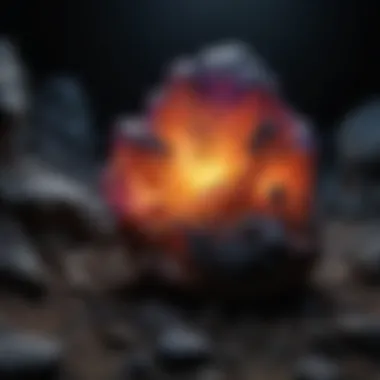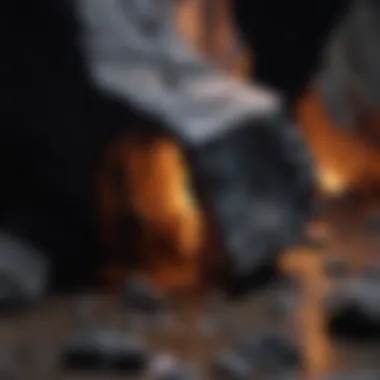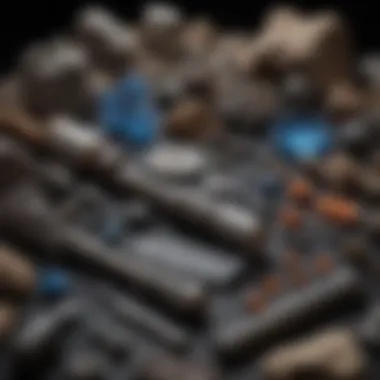Unveiling Hidden Wonders: A Deep Dive into Black Light Online for Rock and Fossil Collectors


Rock and Fossil Identification
In the realm of rock and fossil identification, it is essential for collectors to familiarize themselves with the various types of rocks and fossils that exist. Differentiating between sedimentary, igneous, and metamorphic rocks, as well as ancient plant and animal remains preserved in fossils, is crucial in building a comprehensive collection. Understanding the distinct characteristics of each type is key to identifying and appreciating the unique qualities they possess.
Exploring the world of black light online presents a novel approach to rock and fossil identification. The use of black light technology can unveil hidden fluorescent minerals that may not be visible under normal lighting conditions. By harnessing the fluorescence of certain minerals, collectors can enhance their ability to identify and classify specimens with greater precision.
To aid in the identification process, collectors may utilize specialized tools such as UV lamps and magnification devices. These tools allow for closer examination of mineral properties and surface textures, facilitating the recognition of key features that distinguish one rock or fossil type from another.
Introduction to Black Light Online
Black light technology has revolutionized the way rock and fossil collectors explore their geological specimens. By shedding light on the unseen fluorescent qualities of minerals, black light online opens up a realm of hidden wonders within collections. This section will delve into the fundamentals of black light technology, its practical applications in the realm of geological specimens, and the benefits it offers to enthusiasts seeking to elevate their collecting experience.
Understanding Black Light Technology
The Science Behind Black Light:
The science behind black light is rooted in the properties of ultraviolet (UV) light, specifically UVA wavelengths, which are responsible for inducing fluorescence in certain minerals. This aspect of black light is crucial in revealing the hidden fluorescence present in geological specimens, adding a new dimension to rock and fossil collecting. Despite its efficacy in showcasing fluorescent qualities, prolonged exposure to UV light can be harmful, necessitating caution and proper usage.
Properties of Ultraviolet Light:
Ultraviolet light encompasses UVA, UVB, and UVC rays, with UVA being the most common choice for rock and fossil collectors due to its ability to induce fluorescence while possessing lower risks compared to UVB and UVC. Understanding the properties of UV light is essential for effective fluorescent mineral identification and enhancement of display aesthetics.
Fluorescence in Minerals:
Fluorescence in minerals is a phenomenon where certain specimens emit visible light when exposed to UV radiation. This unique feature allows collectors to distinguish between different minerals based on their fluorescent patterns, aiding in identification and classification. However, not all minerals exhibit fluorescence, requiring a nuanced approach in utilizing black light technology to unveil these hidden qualities.
Applications in Rock and Fossil Collecting
Identification of Fluorescent Minerals:
The identification of fluorescent minerals under black light is a key application for rock and fossil collectors, enabling them to differentiate between specimens based on their unique fluorescence patterns. This aspect not only enhances the aesthetic appeal of collections but also aids in authentication and categorization of geological finds.


Detection of Inauthentic Specimens:
Black light technology plays a crucial role in detecting inauthentic specimens within collections, as certain treatments or enhancements exhibit distinctive fluorescence under UV light. By utilizing black light online, collectors can scrutinize their specimens for any artificial alterations, ensuring the integrity of their geological displays.
Enhancing Display Aesthetics:
Enhancing display aesthetics through black light technology transforms traditional rock and fossil showcases into captivating visual experiences. By strategically incorporating UV lighting, collectors can emphasize the fluorescent qualities of minerals, creating dynamic and engaging displays that highlight the natural beauty of geological specimens.
Tools and Techniques for Black Light Exploration: When delving into the world of rock and fossil collecting, understanding the intricate mechanisms of black light technology becomes pivotal. This section serves as a comprehensive guide to the various tools and techniques essential for effective exploration under black light. Discussed in detail are the significance of black lights in revealing hidden fluorescent minerals, enhancing display aesthetics, and aiding in authenticity verification processes. By focusing on specific elements like UVA, UVB, and UVC lights, readers will gain insight into selecting the ideal black light source for their collection. Additionally, exploring the advantages and considerations of portable versus stationary models sheds light on the practical aspects of utilizing black light for geological specimens. Ensuring a thorough understanding of the tools and techniques for black light exploration is fundamental for enthusiasts looking to unveil the hidden wonders within their prized collections.Types of Black Lights: UVA, UVB, and UVC: The distinction between UVA, UVB, and UVC lights holds paramount importance in the realm of black light exploration. Each type possesses unique characteristics that contribute significantly to the overall efficiency of illuminating fluorescent minerals. Understanding the specific attributes of UVA, UVB, and UVC aids collectors in choosing the most suitable black light source based on their intended purposes. From the benefits of UVA for highlighting longwave fluorescence to the advantages of UVB in detecting minerals with mid-range fluorescence, each type offers a distinct contribution to the exploration process. Furthermore, the versatility of UVC in capturing shortwave fluorescence adds a dynamic element to the spectrum of black light options available, enriching the overall experience of rock and fossil enthusiasts. Appreciating the nuances of UVA, UVB, and UVC lights is essential for collectors seeking to optimize their black light exploration journeys and unlock the full potential of their geological treasures.Choosing the Right Black Light Source: Navigating the diverse array of black light sources necessitates a nuanced understanding of what constitutes the
Creating a Black Light Display Showcase
In the realm of rock and fossil collecting, the creation of a captivating Black Light Display Showcase holds significant importance. It serves as a platform to showcase the beauty and unique features of fluorescent minerals, elevating the overall aesthetic appeal of geological specimens. By designing an engaging display, collectors can not only highlight the hidden patterns and colors within their collection but also attract attention and spark curiosity among viewers.
Emphasizing the intricacies of Choosing Display Accessories is crucial in enhancing the impact of the showcase. The careful selection of display accessories such as UV-protective glass cases, reflective backdrops, and adjustable lighting fixtures plays a pivotal role in ensuring the optimal presentation of fluorescent minerals. Each accessory is chosen thoughtfully to complement the specimens, setting the stage for a visually stunning display that captivates the audience.
On the topic of Optimizing Lighting Arrangements, the strategic placement of UV lights is essential for maximizing the fluorescence of minerals and fossils under black light. By illuminating specimens from various angles and distances, collectors can unveil the full spectrum of colors and patterns that might otherwise remain unnoticed. This meticulous arrangement not only enhances the vibrancy of display but also adds a layer of depth and intrigue to the overall presentation.
Furthermore, Incorporating Fluorescent Artifacts into the display adds an extra dimension of storytelling and artistry to the showcase. By interspersing naturally fluorescent minerals with custom-made fluorescent art pieces or artifacts, collectors can create a dynamic and visually stimulating exhibition. This fusion of geological wonders with artistic elements not only enriches the viewer's experience but also opens avenues for creative expression within the realm of rock and fossil collecting.
Designing an Aesthetic Presentation
Choosing Display Accessories
Choosing the right Display Accessories is paramount in ensuring the successful presentation of fluorescent minerals in a Black Light Display Showcase. UV-protective glass cases provide essential protection for specimens while allowing for optimal viewing under black light. Reflective backdrops enhance the fluorescence by creating a play of light and shadows that accentuate the minerals' natural beauty. Adjustable lighting fixtures offer flexibility in illuminating specimens from different angles, enhancing their visual appeal and creating a captivating display.
Optimizing Lighting Arrangements
Optimizing Lighting Arrangements is key to maximizing the showcasing potential of fluorescent minerals in a Black Light Display Showcase. Strategic placement of UV lights ensures that specimens are illuminated effectively, bringing out their vibrant colors and intricate patterns. By experimenting with different lighting angles and intensities, collectors can create a dynamic display that highlights the unique features of each mineral while providing an immersive viewing experience for visitors.
Incorporating Fluorescent Artifacts
Incorporating Fluorescent Artifacts adds an artistic flair to the display, creating a visually captivating experience for viewers. By mixing naturally fluorescent minerals with custom-made fluorescent art pieces, collectors can tell a story through their showcase, engaging the audience on both an aesthetic and intellectual level. The fusion of geological specimens with artistic elements not only enhances the overall presentation but also fosters a deeper appreciation for the beauty and complexity of fluorescent minerals.


Interactive Display Ideas
Educational Components
When exploring Interactive Display Ideas, the inclusion of Educational Components is fundamental to engaging the audience and enhancing the learning experience. By incorporating informative plaques, brochures, or interactive displays, collectors can provide valuable insights into the geological significance and properties of fluorescent minerals. Educational components serve to enlighten viewers and promote a deeper understanding of the rock and fossil collecting hobby.
Interactive Elements for Viewers
Integrating Interactive Elements for Viewers creates an immersive and participatory experience within the Black Light Display Showcase. Hands-on activities, interactive touchscreens, or 3D models allow visitors to engage with the specimens actively, fostering curiosity and knowledge exploration. By encouraging interaction, collectors can spark interest and create memorable experiences that resonate with viewers long after their visit.
Informational Signage
Informational Signage plays a vital role in conveying key details about the displayed specimens and artifacts. Clear and concise signage describing the origins, properties, and significance of fluorescent minerals enriches the viewer's understanding and appreciation. Additionally, providing information on conservation efforts and collecting ethics promotes awareness and responsible stewardship of geological resources.
Maintenance and Care Tips
Cleaning Procedures for Display Cases
Proper Cleaning Procedures for Display Cases are essential to maintain the pristine condition of fluorescent minerals and artifacts. Regular dusting and cleaning of display surfaces prevent the accumulation of debris that could detract from the specimens' brilliance under black light. Using gentle cleaning agents and soft cloth ensures that the display cases remain free of smudges or residue, allowing the specimens to shine through in all their fluorescent glory.
Regular Inspection of Light Sources
Regular Inspection of Light Sources is crucial for ensuring consistent and optimal illumination within the showcase. Periodic checks for bulb functionality, dust accumulation, and proper alignment of UV lights help prevent inconsistencies in lighting that may affect the display quality. By conducting routine inspections, collectors can address any maintenance issues promptly, guaranteeing a seamless viewing experience for visitors.
Preventative Measures for Specimen Damage
Implementing Preventative Measures for Specimen Damage is key to preserving the integrity of geological specimens showcased under black light. Shielding delicate minerals from direct sunlight exposure, managing humidity levels, and avoiding physical handling help mitigate the risk of potential damage. By proactively safeguarding the specimens, collectors can prolong their longevity and maintain their allure for future generations to appreciate.
Exploration and Discovery Through Black Light
In the realm of rock and fossil collecting, the exploration and discovery through black light present a significant facet that unveils hidden marvels within geological specimens. By utilizing black light technology, enthusiasts can delve into natural settings with a new lens, enhancing their understanding and appreciation of fluorescent minerals. This section delves into the crucial role of exploration and fieldwork using black light, offering rock and fossil collectors a unique perspective on their collections and the surrounding geological world.
Field Trips and Excursions


Utilizing Black Light in Natural Settings
Utilizing black light in natural settings allows collectors to reveal the true beauty and intricacies of fluorescent minerals in their organic habitat. By shining UV light on geological specimens in situ, collectors can witness the vibrant fluorescence that is otherwise invisible to the naked eye. This immersive experience adds a layer of authenticity to the exploration process, making it a preferred method for enthusiasts seeking genuine interactions with their collections.
Documenting Field Discoveries
Documenting field discoveries plays a crucial role in preserving geological findings and sharing valuable insights with the community. By meticulously recording details of specimens found under black light, collectors contribute to the scientific understanding of fluorescent minerals and their natural occurrences. This practice not only aids in personal research but also fosters a culture of knowledge-sharing among rock and fossil enthusiasts.
Community Engagement Activities
Engaging in community activities centered around black light exploration strengthens the bond among collectors and fosters a collaborative spirit. By organizing group outings, workshops, and educational events, enthusiasts can share their passion for geological discoveries and inspire others to join the hobby. Community engagement not only enhances the learning experience but also promotes camaraderie and cooperation in the pursuit of scientific knowledge.
Collaborative Projects and Research
Contributing to Scientific Studies
Active participation in scientific studies related to black light exploration enriches the understanding of geological phenomena and contributes valuable data to the scientific community. By conducting experiments, sharing findings, and collaborating with experts, collectors play a vital role in advancing the knowledge of fluorescent minerals and their properties. This collaborative approach not only benefits individual research but also elevates the collective understanding of geological processes.
Partnerships with Geological Institutions
Establishing partnerships with geological institutions creates opportunities for shared research, resources, and expertise in the field of black light exploration. By collaborating with experts, collectors can gain access to specialized equipment, laboratories, and scientific knowledge that enhance their exploration capabilities. These partnerships foster a culture of mutual learning and growth, leading to enriched discoveries and a deeper appreciation for the geological world.
Sharing Findings Online
Sharing findings online through platforms and forums dedicated to rock and fossil collecting allows enthusiasts to connect, exchange ideas, and showcase their discoveries to a wider audience. By creating digital repositories of field observations, photographs, and research data, collectors contribute to a vast pool of knowledge accessible to fellow enthusiasts worldwide. This sharing culture not only promotes transparency and collaboration but also inspires others to explore the fascinating realm of black light geology.
Inspiring Others in the Hobby
Educational Workshops and Seminars
Conducting educational workshops and seminars on black light exploration imparts valuable knowledge and practical skills to aspiring enthusiasts. By sharing expertise, techniques, and best practices, experienced collectors can mentor newcomers and guide them on their journey of discovery. These interactive sessions not only educate but also inspire a new generation of rock and fossil enthusiasts to explore the wonders of black light geology.
Mentoring New Enthusiasts
Mentoring new enthusiasts in the intricacies of black light exploration cultivates a culture of learning, curiosity, and conservation within the hobby. By offering guidance, support, and hands-on experience, seasoned collectors can nurture the next wave of geology enthusiasts and instill a sense of responsibility towards environmental conservation. This mentorship approach not only transfers knowledge but also fosters a sense of community and stewardship among practitioners of black light geology.
Promoting Conservation Efforts
Promoting conservation efforts in conjunction with black light exploration emphasizes the importance of preserving natural resources and habitats for future generations. By advocating for sustainable practices, ethical collecting methods, and environmental awareness, enthusiasts can contribute to the long-term health and vitality of geological ecosystems. This conservation ethos not only protects rare specimens and fragile environments but also instills a sense of respect and mindfulness among rock and fossil collectors.







